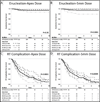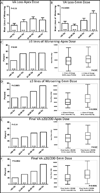Uveal melanoma treated with iodine-125 episcleral plaque: an analysis of dose on disease control and visual outcomes
- PMID: 24613808
- PMCID: PMC3988201
- DOI: 10.1016/j.ijrobp.2014.01.026
Uveal melanoma treated with iodine-125 episcleral plaque: an analysis of dose on disease control and visual outcomes
Abstract
Purpose: To investigate, in the treatment of uveal melanomas, how tumor control, radiation toxicity, and visual outcomes are affected by the radiation dose at the tumor apex.
Methods and materials: A retrospective review was performed to evaluate patients treated for uveal melanoma with (125)I plaques between 1988 and 2010. Radiation dose is reported as dose to tumor apex and dose to 5 mm. Primary endpoints included time to local failure, distant failure, and death. Secondary endpoints included eye preservation, visual acuity, and radiation-related complications. Univariate and multivariate analyses were performed to determine associations between radiation dose and the endpoint variables.
Results: One hundred ninety patients with sufficient data to evaluate the endpoints were included. The 5-year local control rate was 91%. The 5-year distant metastases rate was 10%. The 5-year overall survival rate was 84%. There were no differences in outcome (local control, distant metastases, overall survival) when dose was stratified by apex dose quartile (<69 Gy, 69-81 Gy, 81-89 Gy, >89 Gy). However, increasing apex dose and dose to 5-mm depth were correlated with greater visual acuity loss (P=.02, P=.0006), worse final visual acuity (P=.02, P<.0001), and radiation complications (P<.0001, P=.0009). In addition, enucleation rates were worse with increasing quartiles of dose to 5 mm (P=.0001).
Conclusions: Doses at least as low as 69 Gy prescribed to the tumor apex achieve rates of local control, distant metastasis-free survival, and overall survival that are similar to radiation doses of 85 Gy to the tumor apex, but with improved visual outcomes.
Copyright © 2014 Elsevier Inc. All rights reserved.
Conflict of interest statement
Figures



References
-
- Singh AD, Turell ME, Topham AK. Uveal melanoma: Trends in incidence, treatment, and survival. Ophthalmology. 2011;118:1881–1885. - PubMed
-
- Collaborative Ocular Melanoma Study G. The coms randomized trial of iodine 125 brachytherapy for choroidal melanoma: V. Twelve-year mortality rates and prognostic factors: Coms report no. 28. Archives of ophthalmology. 2006;124:1684–1693. - PubMed
-
- Melia BM, Abramson DH, Albert DM, Boldt HC, Earle JD, Hanson WF, Montague P, Moy CS, Schachat AP, Simpson ER, Straatsma BR, Vine AK, Weingeist TA Collaborative Ocular Melanoma Study G. Collaborative ocular melanoma study (coms) randomized trial of i-125 brachytherapy for medium choroidal melanoma. I. Visual acuity after 3 years coms report no. 16. Ophthalmology. 2001;108:348–366. - PubMed
-
- Gragoudas ES, Lane AM, Regan S, Li W, Judge HE, Munzenrider JE, Seddon JM, Egan KM. A randomized controlled trial of varying radiation doses in the treatment of choroidal melanoma. Archives of ophthalmology. 2000;118:773–778. - PubMed
Publication types
MeSH terms
Substances
Grants and funding
LinkOut - more resources
Full Text Sources
Other Literature Sources
Medical
Miscellaneous

